Art & Exhibitions
10 Incredible Ways Fashion and Technology Merge at the Met’s Costume Institute Show
Andrew Bolton declares that a new aesthetic is emerging.
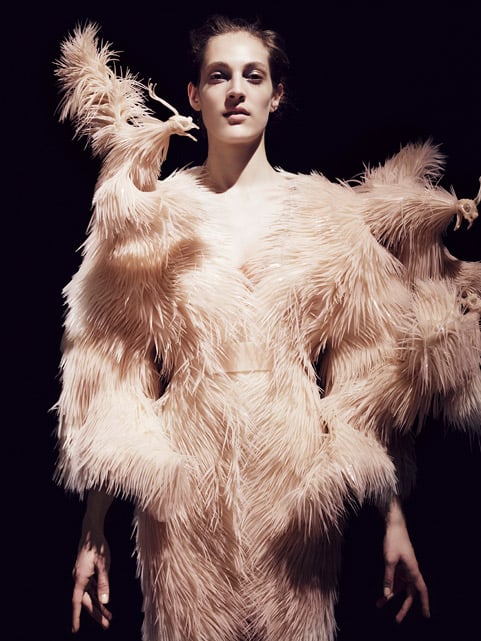
Andrew Bolton declares that a new aesthetic is emerging.

Christie Chu

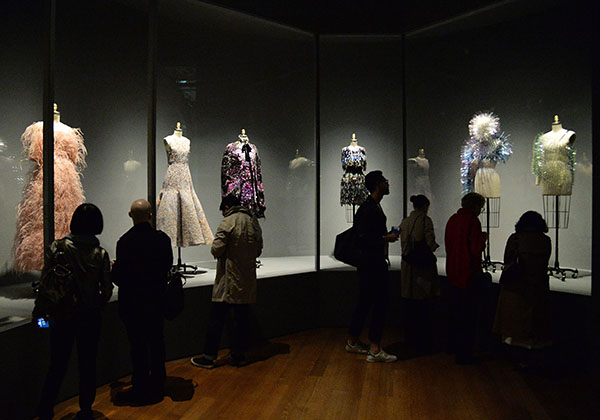
NEW YORK, NY – MAY 02: Dresses on display at the Costume Institute’s “Manus x Machina” exhibition press presentation at the Metropolitan Museum of Art at Metropolitan Museum of Art on May 2, 2016 in New York City. (Photo by Slaven Vlasic/Getty Images)
“A new aesthetic is emerging,” declared curator of the Metropolitan’s Costume Institute Andrew Bolton, just hours before the Met Gala would take place at the venerable New York institution. For this year’s Costume Institute exhibition, the Met presents “Manus x Machina” a look at how fashion has evolved alongside the invention of new technologies. Housed in the museum’s Robert Lehman Wing, Rem Koolhaas’s architecture firm, OMA, transformed the space into a futuristic temple for fashion.
Bolton said at the press preview he was inspired by Yves Saint Laurent’s Mondrian dress from his Fall 1965 couture collection. Upon examining its construction with conservators “we discovered it was almost entirely made by machine, in fact the only presence of the hand was in the hem and the zipper.” Bolton mentioned he was “surprised because traditionally the distinction between haute couture and prêt-à-porter had always been the hand-made and machine-made respectively.”
The point, then, of this exhibition is to question this dialectic and to reveal that hand-made and machine-made are often exercised in tandem.
With over 160 ensembles, spanning from the early 20th century to the present, here we pick the 10 incredible ways fashion and technology go hand in hand.
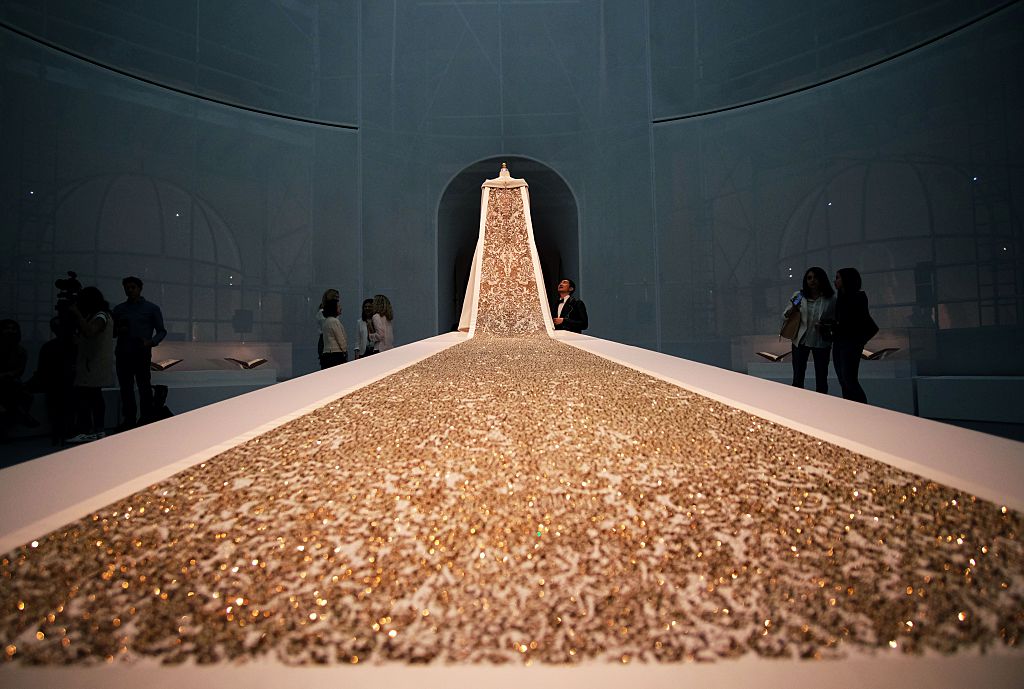
A costume is displayed during the press preview of the Metropolitan Museum of Arts Costume Institute spring 2016 exhibition “Manus x Machina: Fashion in an Age of Technology” in New York on May 2, 2016. / AFP / JEWEL SAMAD (Photo credit should read JEWEL SAMAD/AFP/Getty Images)
1. Chanel by Karl Lagerfeld, Wedding Ensemble, 2014
This wedding dress designed by Karl Lagerfeld for Chanel is the first item one sees when walking into the exhibition. With a 10-foot glittering train, it steals the spotlight. Created from scuba knit, a synthetic material, the dress was hand molded, machine sewn, and hand embroidered with gold, glass, and crystal rhinestones. Lagerfeld’s initial hand-drawn design for the train was later digitally altered to give the look of a pixelated baroque pattern.
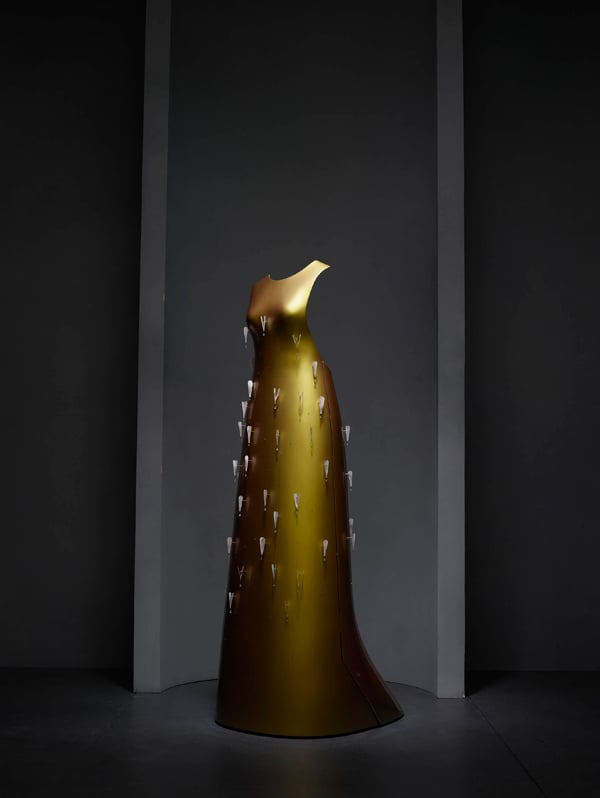
Dress by Hussein Chalayan. Image: Christie Chu
2. Hussein Chalayan, “Kaikoku” Floating Dress, 2011
The British-Turkish designer’s fiberglass dress immediately pulls the viewer in with its sculptural delicacy. This is no ordinary ensemble. On closer examination one can see the dress is painted with gold pigment and covered in 50 “pollens” made from pearled paper and crystals. The wearer of this bionic outfit steps into it through a rear-access panel—the entire garment is operated via remote control. Each “pollen” attached to the dress at one point, can be spring loaded, in which all 50 will be released into the air and swirl above the wearer.
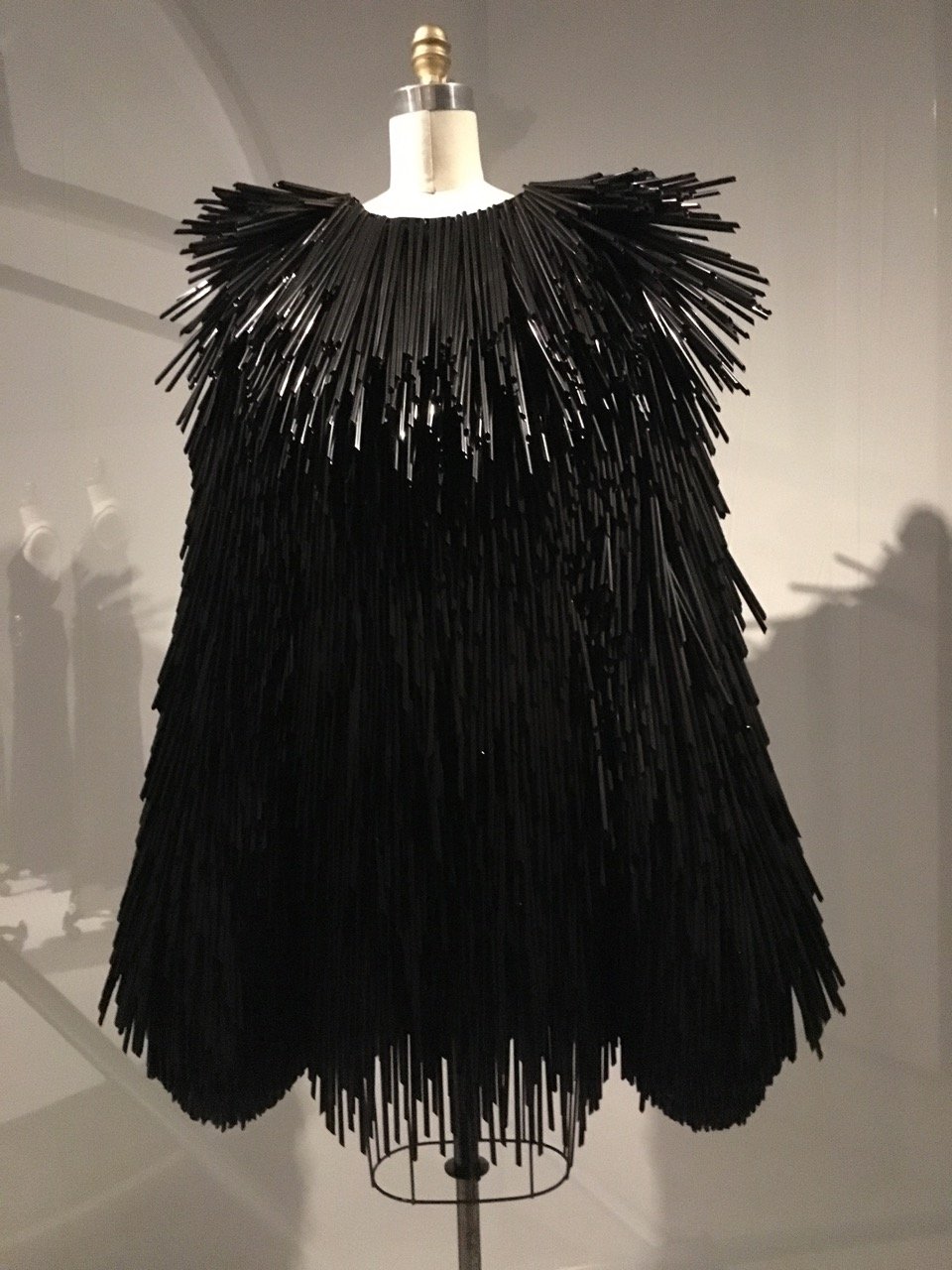
Dress by Gareth Pugh. Image: Christie Chu.
3. Gareth Pugh, Dress, 2015
English fashion designer Gareth Pugh shows a machine-sewn wool gazar. The black tunic-length garb is made entirely from plastic drinking straws, hand-cut and hand-sewn onto the garment. Each straw was attached by metal hardware that hooked onto the mesh base. The designer said of the piece “you could hear them before you saw them… they moved beautifully—like feathers caught in a gust of wind.”
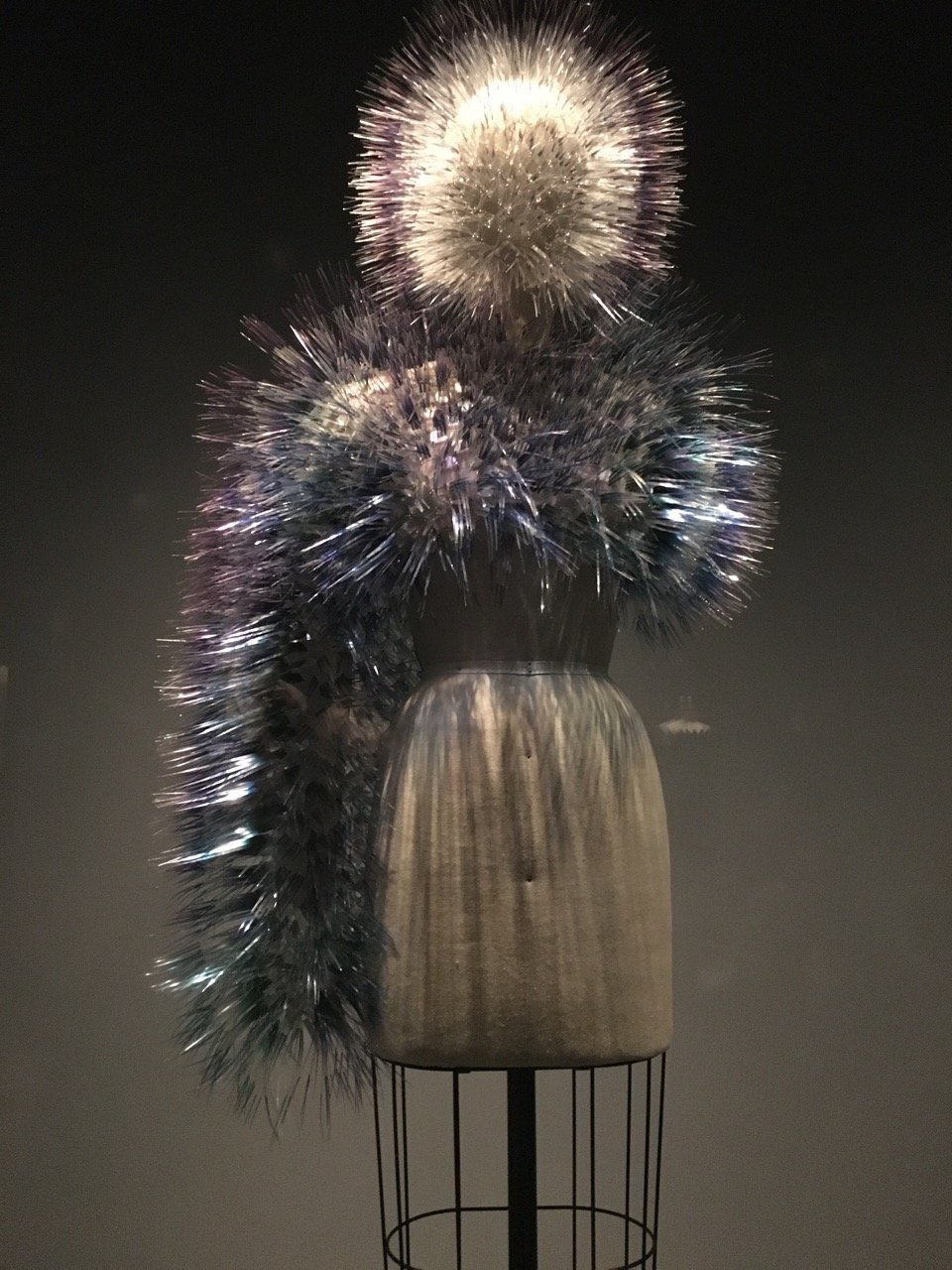
Bolero by Maiko Takeda. Image: Christie Chu.
4. Maiko Takeda, “Atmospheric Reentry” Headpiece and Bolero, 2013
If you were tuned into pop culture last year, you would recognize this headpiece and bolero ensemble from Japanese-born designer Maiko Takeda. Recording artist Bjork, who had a retrospective at the MoMA in 2015, wore it on the cover of her latest album, Vulnicura. Tekada wanted to create the visual effect of an “aura” using relatively low-tech materials. Despite its techno look, the hand-cut acetate and acrylic headpiece was entirely made by linking materials together with jump rings.
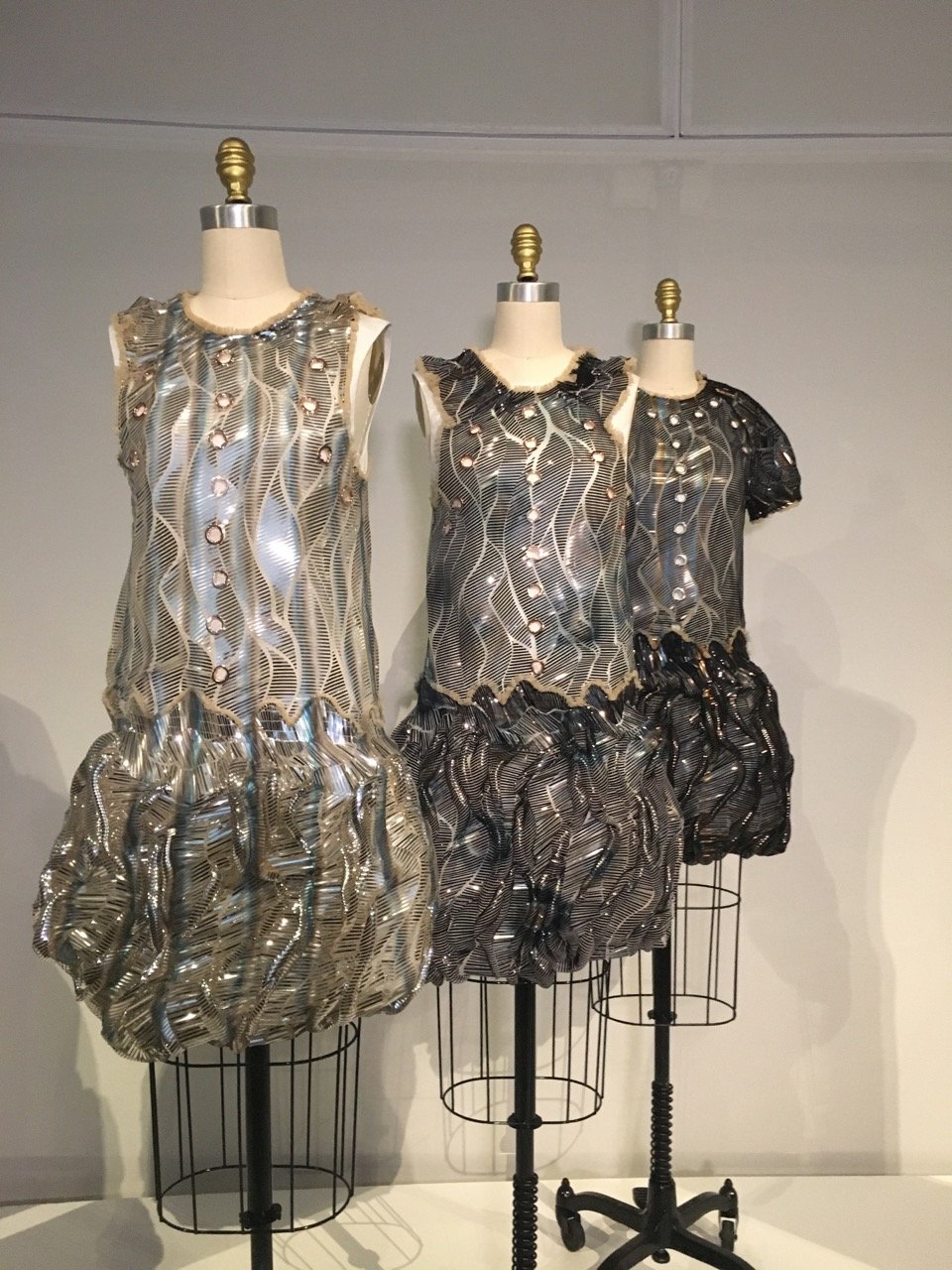
Dress by Nicolas Guesquiere for Louis Vuitton. Image: Christie Chu
5. Louis Vuitton by Nicolas Guesquière, Dress, 2016
French designer Nicolas Guesquière harmoniously captures the essence of “manus” and “machina” with these Louis Vuitton dresses from the 2016 spring/summer collection. The ensembles were made from celluloid sequins that were cut into strips by laser and then machine glued onto tulle. When the designer began to drape the machine-made fabric on the model, “bubbles began to form, and the sequins took on the shape of a croissant.” Afterwards the dresses were spray-painted by hand to create shadows in the folds.
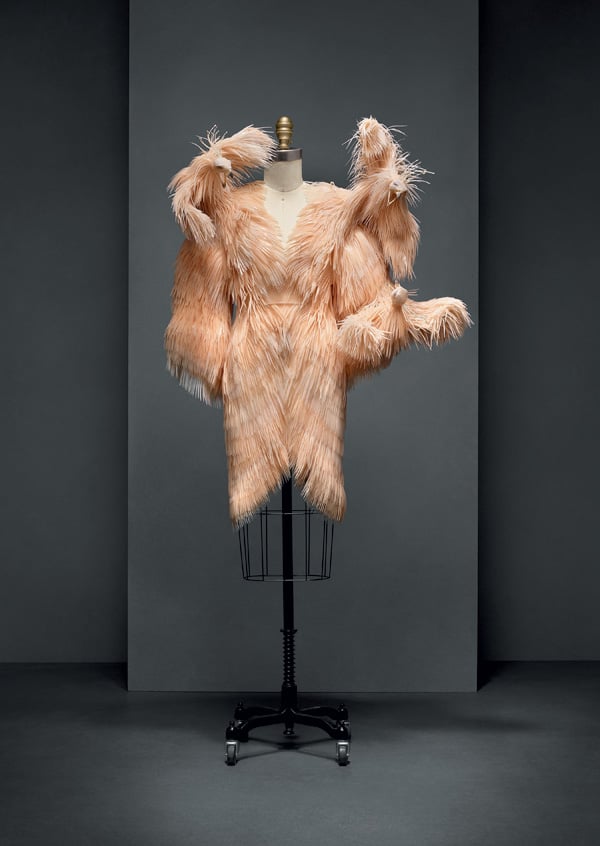
Dress by Iris Van Herpen. Image: Christie Chu
6. Iris Van Herpen, Dress, 2013
Dutch designer Iris Van Herpen created this masterpiece with strips of laser-cut nude silicone feathers, cotton twill, and silicone-coated bird skulls with synthetic pearls and glass eyes. Van Herpen describes the process as “very complicated.” Her team created the silicone mixture, poured it, and laser cut it, two strokes at a time. Once the silicone sheets were done, they hand-stitched them to the base fabric of the dress. Afterwards the real bird skeleton heads were attached to the garment.
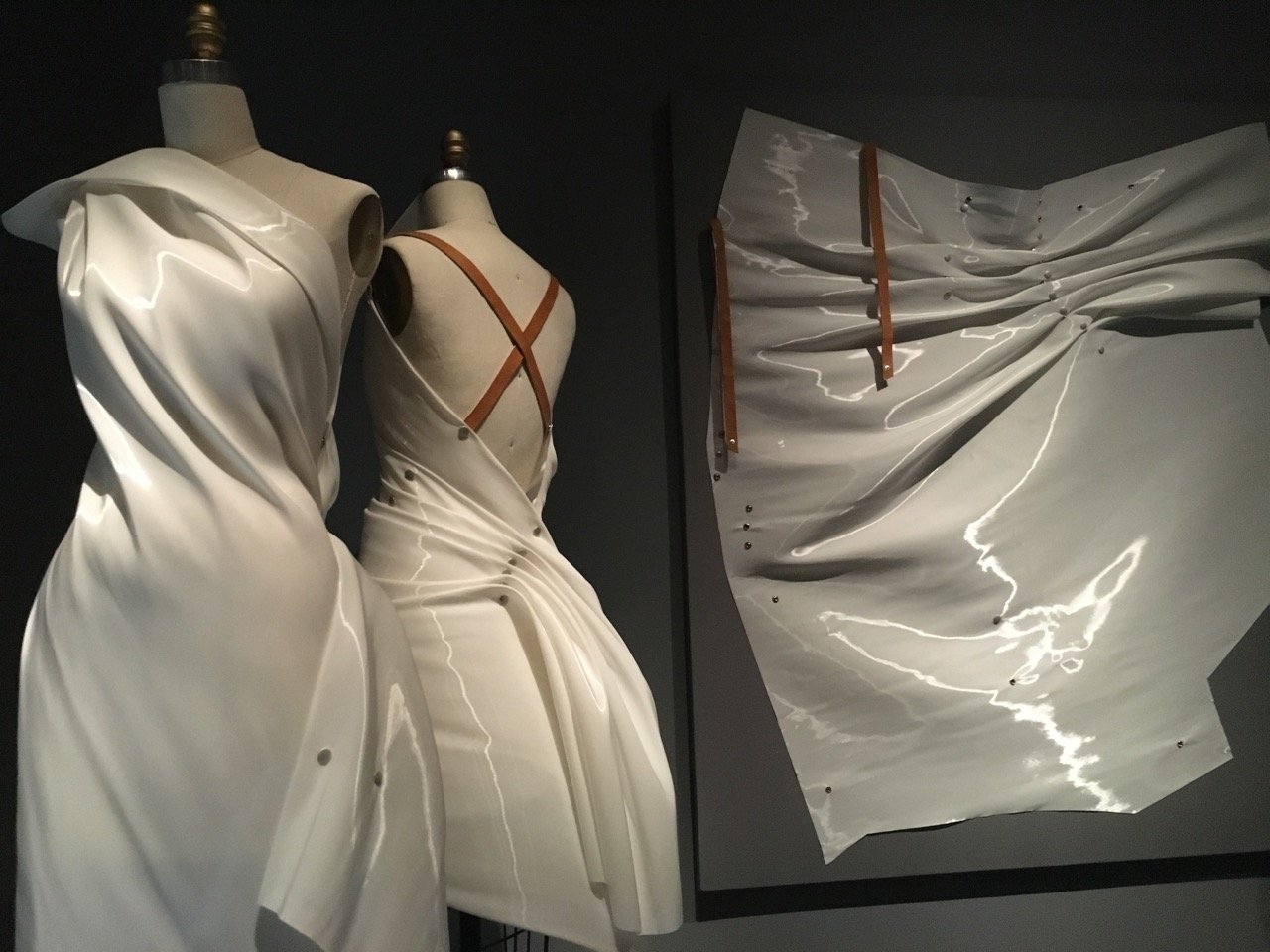
Dress by Issey Miyake. Image: Christie Chu
7. Issey Miyake, Colombe, 1991
Master of pleats and draping, Issey Miyake’s Colombe dress came from a dream to create a piece of clothing that wasn’t made from any “conventional tools, such as needles, threads, and scissors.” The result is a beautiful white dress made from woven monofilament (material used for fishing lines) with natural colored leather straps in which the wearer snaps into. Like all of Miyake’s ingenious designs, when unworn, the fabric looks akin to a work of fine art.
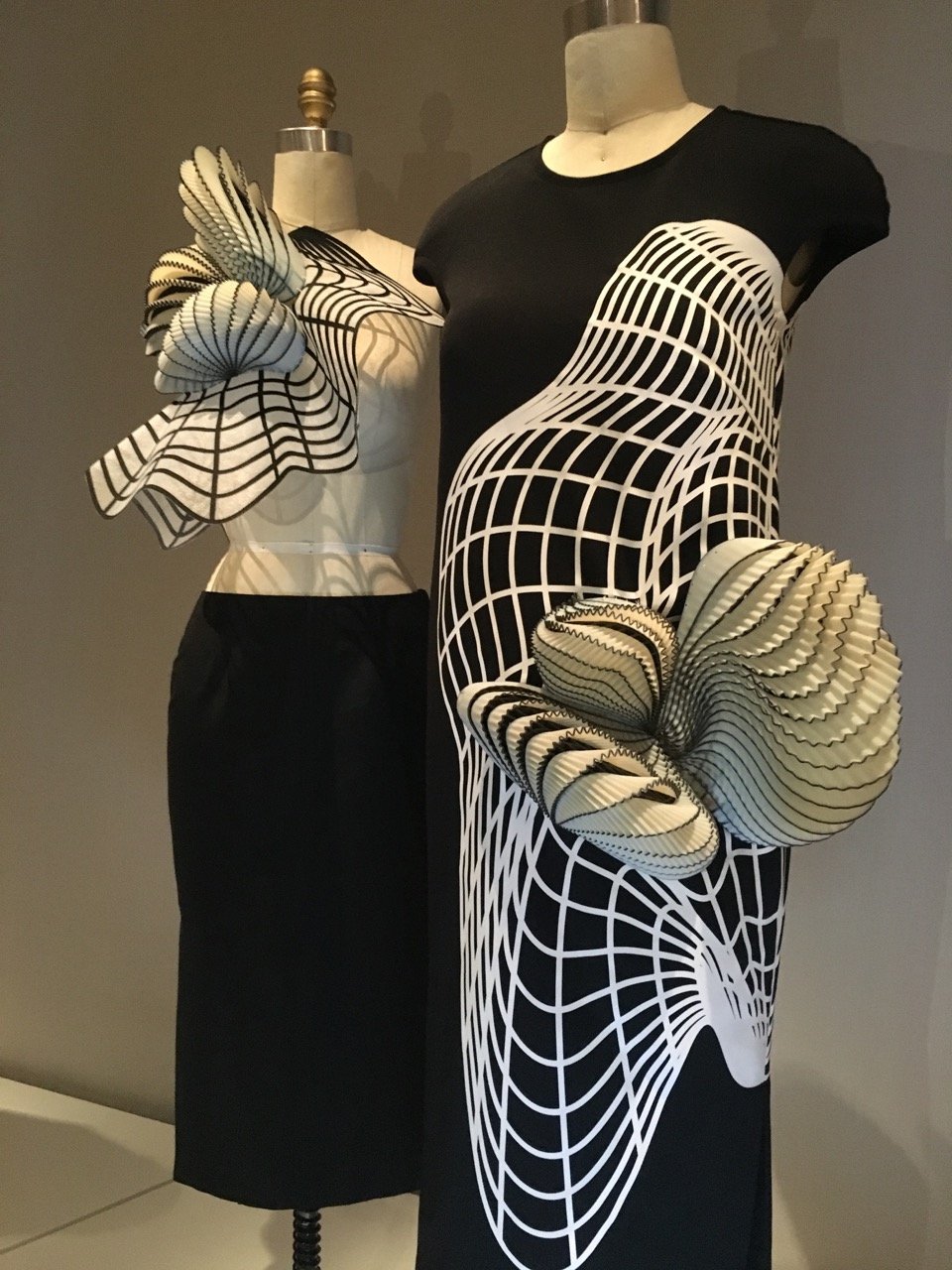
Dress by Noa Raviv. Image: Christie Chu
8. Noa Raviv, Dress, 2014
Israeli-born designer Noa Raviv employed the relatively new technology of 3-D printing for this black and white optical dress. The polymer printed by machine was attached at the hip of the dress to give the illusion of the garment coming alive, slowing transitioning from 2-D to 3-D. Raviv’s use of printing technology comes at a time when numerous goods, from make-up to firearms, are being designed digitally and then transformed into consumable commodities. Will printing custom clothing to fit our bodies be next?
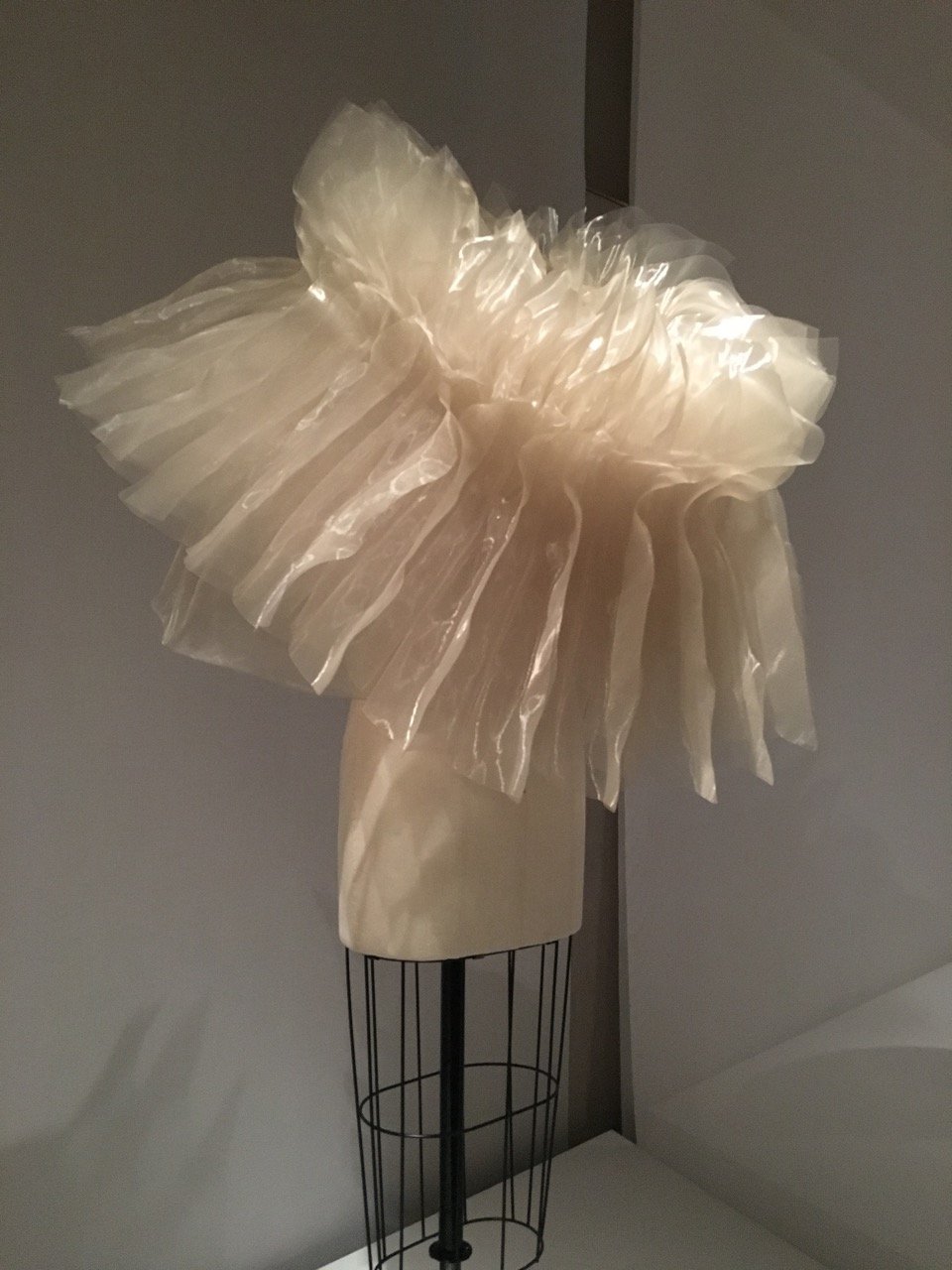
“Ruff” by Junya Watanabe for Commes Des Garcons. Image: Christie Chu
9. Commes Des Garçons by Junya Watanabe, Ruff, 2000
If anyone knows how to do avant-garde, it’s Commes Des Garçons. The cult label created by Japanese designer Rei Kawakubo is known for its incredibly cool, sculptural, and mostly unwearable runway looks. Here Kawakubo’s protégé, Junya Watanabe, designs an exaggerated ruff from polyester organza, an item of clothing worn around the neck in Western Europe during the Renaissance.
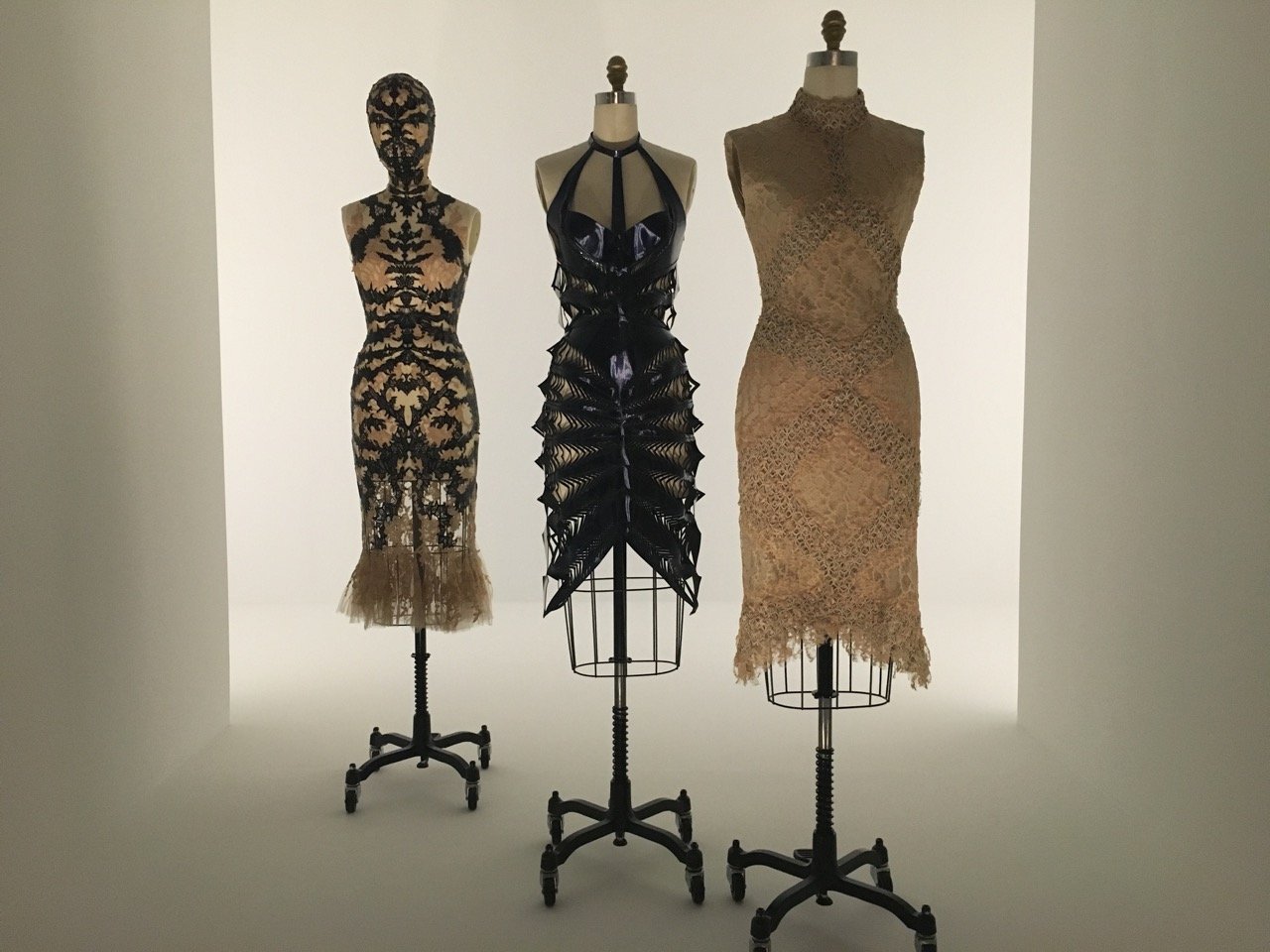
Dress by Sarah Burton for Alexander McQueen. Image: Christie Chu
10. Alexander McQueen by Sarah Burton, Dress, 2012 (far left)
Designer Sarah Burton combined the crafts of leatherwork and lacework in this labor-intensive dress. Inspired by coral skeleton, the dress looks both hard and soft with hand-made lace and laser-cut patent leather simultaneously in opposition and in harmony.
“Manus x Machina” opens May 5-August 14 at the Metropolita Museum of Art.